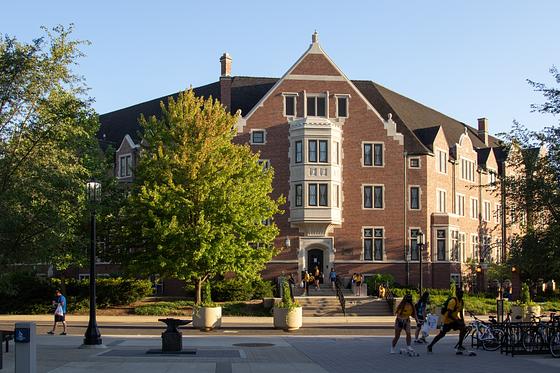Applying to universities in the United States can be an exciting and transformative journey for international students. With its rich academic offerings, diverse campus communities, and global opportunities, the US education system attracts students from around the world. This article aims to provide a comprehensive overview of key considerations for international students applying to US universities.
Let us slide into your dms 🥰
Get notified of top trending articles like this one every week! (we won't spam you)Location
The United States is geographically vast and culturally diverse. When choosing a university, consider the location carefully. Factors such as climate, urban vs. rural settings, and proximity to major cities or cultural attractions can influence your experience. Research universities across different regions, from the bustling East Coast to the scenic West Coast, to find the environment that suits you best.
The United States is geographically diverse, offering a wide array of climates, landscapes, and cultural nuances across different regions. Students can choose from universities located on the sunny beaches of California, amidst the historic charm of New England, in the vibrant Southern states, or amidst the awe-inspiring Rocky Mountains. Each region presents its own unique experiences, traditions, and opportunities for exploration, allowing teenagers to find a location that aligns with their personal preferences and interests.

Image from Unsplash
Several US universities are strategically located near industry and innovation hubs, providing students with valuable exposure to cutting-edge research, technology, and entrepreneurial opportunities. Universities situated in or near tech-centric cities like Silicon Valley or the Research Triangle Park can offer access to internships, collaborations with industry leaders, and networking opportunities that can shape future career paths.
Take the Quiz: What Type of Notes Should I Take?
Discover the best note-taking method for your learning style!
Scholarships and Financial Aid:
Financing your education is a crucial aspect of the application process. Investigate scholarship opportunities available specifically for international students. Many universities offer merit-based scholarships, grants, or need-based financial aid programs. Research and apply to external scholarships as well, and explore any government-sponsored funding options in your home country.
Understanding the different types of scholarships available can help students identify and pursue the most suitable opportunities. Here are some common types of scholarships offered by US universities:
1. Need-Based Scholarships: Need-based scholarships are awarded to students based on their financial need. Universities evaluate applicants' financial circumstances through a comprehensive assessment of their family's income, assets, and other relevant factors.
These scholarships aim to bridge the gap between a student's financial resources and the cost of tuition, ensuring that education remains accessible to all. Need-blind institutions evaluate applications without considering the applicant's financial circumstances, ensuring that financial need does not impact admissions decisions. Need-aware institutions, on the other hand, may take into account the financial need of applicants when making admissions decisions or awarding scholarships.

Image from Unsplash
2. Merit-Based Scholarships: Merit-based scholarships are awarded to students who demonstrate exceptional academic achievements, talents, or skills. These scholarships recognize and reward students for their outstanding performance in academics, arts, athletics, leadership, or community involvement. Merit scholarships are often highly competitive and can cover a significant portion of tuition costs or provide additional benefits like stipends or research opportunities.

Image from Unsplash
3. Athletic Scholarships: Athletic scholarships are awarded to student-athletes who excel in their chosen sport. These scholarships are offered by universities to recruit talented athletes and build competitive sports teams.
Athletic scholarships can cover tuition fees, accommodation, and even provide additional financial support for books and other educational expenses. It's important to note that athletic scholarships may have specific eligibility criteria and requirements, including maintaining athletic performance standards.

Image from Unsplash
4. Talent-Based Scholarships: Talent-based scholarships are awarded to students who demonstrate exceptional abilities in areas such as music, visual arts, performing arts, creative writing, or other specialized skills. These scholarships recognize and support students with outstanding artistic talents, providing them with opportunities to further develop their skills and pursue their passions.
5. Award-Based Scholarships: Award-based scholarships are offered to students who have achieved notable accomplishments in specific fields or have made significant contributions to their communities. These scholarships recognize exceptional achievements, leadership, or service, and can be based on academic performance, community involvement, research projects, entrepreneurial endeavours, or other areas of distinction.

Image from Unsplash
It's important for students to thoroughly research and understand the specific scholarship opportunities offered by each university. Scholarship availability, criteria, and application processes can vary significantly among institutions.
Students should consult university websites, financial aid offices, and scholarship databases to identify relevant opportunities and carefully follow the application instructions and deadlines. By exploring and pursuing the diverse range of scholarships available, students can find the support they need to pursue their educational dreams in the United States.
Majors and Academic Programs:
US universities are renowned for their diverse range of academic programs. Consider your intended major and explore universities known for excellence in that field. Look for faculty expertise, research opportunities, internship programs, and alumni success stories to assess the quality of the department or program you are interested in.
Safety and Campus Security:
Safety is a top priority for international students. When researching universities, explore their safety measures and resources. Look for universities with a low crime rate, well-lit campuses, on-campus security personnel, and support systems for international students. Reach out to current students or alumni to gain insights into their experiences and safety measures on campus.

Image from Unsplash
City and Campus Life:
The lifestyle and cultural environment surrounding the university can greatly impact your overall experience. Consider whether you prefer a vibrant urban setting or a more relaxed college town. Research the availability of extracurricular activities, clubs, and organizations that align with your interests. Engaging in campus life can help you make friends, build a network, and enhance your personal growth.
US universities are often situated in vibrant urban centres, offering teenagers the chance to immerse themselves in thriving cities. Whether it's New York City, Los Angeles, Chicago, or Boston, these locations provide a dynamic environment where students can explore cultural landmarks, arts and entertainment scenes, diverse culinary offerings, and a range of recreational activities. Living in bustling cities also means access to internship and career opportunities, networking events, and a vibrant social life.

Image from Unsplash
In contrast to urban centres, many US universities are nestled in picturesque college towns. These towns are often characterized by a close-knit community atmosphere, beautiful natural surroundings, and a focus on academic pursuits. College towns offer a serene and supportive environment for students to concentrate on their studies while enjoying a more laid-back lifestyle. These towns frequently host cultural events, outdoor activities, and offer ample opportunities for student engagement within the campus community.

Image from Unsplash
Immigration and Visa Regulations:
Understanding the immigration and visa process is crucial for international students. Research the student visa requirements and application process, including necessary documentation and timelines. Familiarize yourself with the restrictions and opportunities available for employment during and after your studies. Stay updated on any changes in immigration policies that may affect international students.
To study in the US as an undergraduate student, international students typically apply for an F-1 student visa. This visa allows students to enroll in accredited educational institutions and remain in the country for the duration of their program. The application process involves securing admission to a US university, providing financial documentation, and obtaining the necessary visa documentation from the US embassy or consulate in their home country.
After completing their undergraduate studies, international students in the US on an F-1 visa can apply for Optional Practical Training (OPT). OPT allows students to work in their field of study for a period of up to 12 months. This provides valuable practical experience, allowing students to apply their knowledge in real-world settings and potentially explore job opportunities in the US.
Image from Unsplash
Students who graduate with degrees in Science, Technology, Engineering, and Mathematics (STEM) may be eligible for an extended period of OPT, known as the STEM OPT extension. This extension allows for an additional 24 months of work authorization in the US, providing a longer timeframe to gain professional experience and potentially secure employment with US-based companies.
Completing university in the US does not guarantee automatic permanent citizenship. However, it can provide a pathway for future immigration opportunities. After graduation, international students may explore employment-based visas such as the H-1B visa, which allows US companies to hire foreign workers with specialized knowledge and skills. While the H-1B visa is not a direct path to citizenship, it can serve as a stepping stone towards obtaining permanent residency or sponsorship for a green card.

Image from Unsplash
International students who secure employment and obtain a work visa may have opportunities to apply for permanent residency (green card) through employer sponsorship or other avenues, such as family-based petitions or self-sponsored options. The process for obtaining permanent residency and eventually citizenship is complex and involves meeting specific criteria set by US immigration laws.
Support Services for International Students:
Look for universities with robust support services for international students. These services may include dedicated international student offices, orientation programs, English language support, cultural adjustment resources, and academic advice tailored to the needs of international students. Supportive communities can ease your transition and help you navigate any challenges.
US universities attract a diverse student body from around the world, fostering a vibrant multicultural environment. Interacting with peers from different backgrounds and cultures broadens horizons, encourages cross-cultural understanding, and helps students develop a global perspective. The cultural exchange that occurs on US campuses contributes to a rich and inclusive community where lifelong friendships and professional networks are formed.

Image from Unsplash
Common App & Essays
The Common Application, also known as Common App, is an online application platform used by hundreds of colleges and universities in the United States. It simplifies the college application process by allowing students to submit a single application to multiple institutions. One essential component of the Common App is the personal essay, a key opportunity for students to showcase their individuality, strengths, and aspirations to college admissions officers.
The Common App essay is a crucial part of the college application because it provides a unique chance for students to present themselves beyond grades, test scores, and extracurricular activities. It allows admissions officers to gain insight into a student's personality, values, experiences, and potential contributions to the campus community. The essay prompts offered by the Common App are designed to be open-ended, encouraging students to reflect on their lives and express themselves creatively.
When writing a Common App essay, it's essential to choose a topic that resonates with you personally and allows you to demonstrate your growth, resilience, and passion. Whether you choose to write about a significant life event, a personal challenge, an influential person, or a thought-provoking idea, the essay should provide a window into your character and reveal something meaningful about who you are as an individual.
Additionally, the Common App provides a range of resources and support for applicants. It offers guidance on college selection, financial aid, and application tips. Students can access a variety of tools and resources to assist them in researching colleges, exploring majors, and understanding admission requirements.
The platform also facilitates communication between applicants and colleges, allowing students to ask questions and seek clarification directly from admissions offices. Some universities have individual or different application platforms. Check this before applying.
Application Deadlines
When applying to universities in the United States, students have the option to apply under different admission plans: Early Decision (ED), Early Action (EA), or Regular Decision (RD). Each of these plans has its own set of considerations, deadlines, and implications for applicants.
1. Early Decision (ED): Early Decision is a binding admission plan in which students commit to attending a specific college if admitted. This plan typically requires applicants to submit their applications by an earlier deadline, usually in November or December, and receive an admission decision by mid-December or January. If accepted, students must withdraw their applications from other colleges and commit to attending the ED institution.
2. Early Action (EA): Early Action is a non-binding admission plan that allows students to apply to colleges early and receive an admission decision earlier than Regular Decision applicants. Unlike ED, students have the freedom to choose whether to accept an offer of admission or consider other options
3. Regular Decision (RD): Regular Decision is the standard admission plan with the latest application deadline. Students typically apply by January 1st and receive admission decisions by March or April. This plan allows students to compare offers from multiple colleges before making a final decision.
Applying to US universities as an international student requires careful research and planning. Consider factors such as location, scholarships, majors, safety, city/campus life, and immigration regulations when selecting universities. Remember to thoroughly explore the opportunities and resources available to international students at each institution. With the right preparation, you can embark on an enriching educational journey in the United States that broadens your horizons and sets you on a path towards success.











